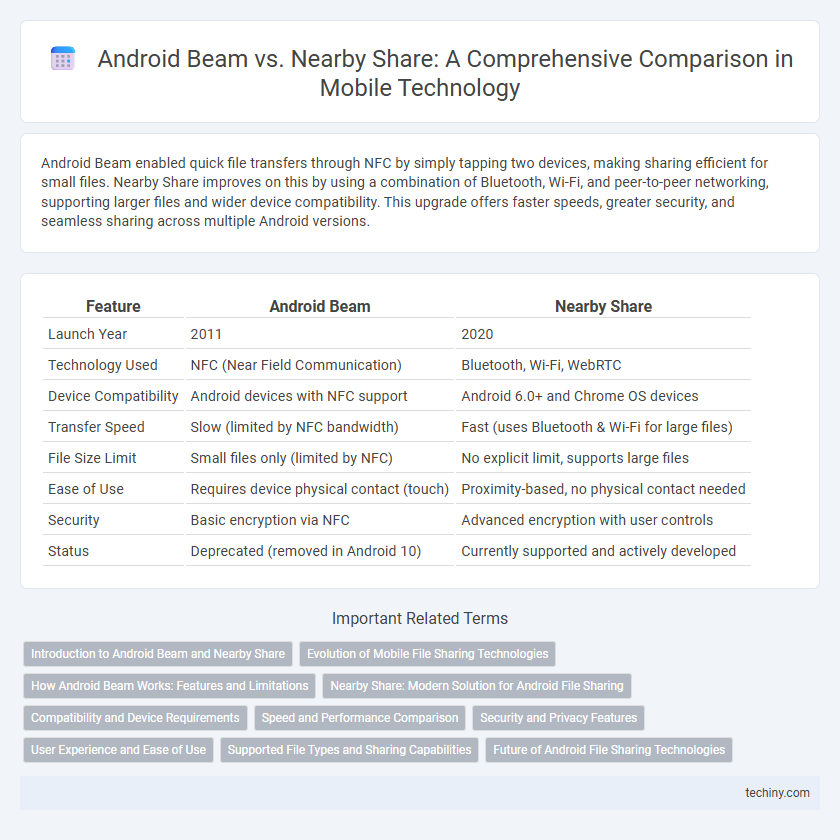Android Beam enabled quick file transfers through NFC by simply tapping two devices, making sharing efficient for small files. Nearby Share improves on this by using a combination of Bluetooth, Wi-Fi, and peer-to-peer networking, supporting larger files and wider device compatibility. This upgrade offers faster speeds, greater security, and seamless sharing across multiple Android versions.
Table of Comparison
| Feature | Android Beam | Nearby Share |
|---|---|---|
| Launch Year | 2011 | 2020 |
| Technology Used | NFC (Near Field Communication) | Bluetooth, Wi-Fi, WebRTC |
| Device Compatibility | Android devices with NFC support | Android 6.0+ and Chrome OS devices |
| Transfer Speed | Slow (limited by NFC bandwidth) | Fast (uses Bluetooth & Wi-Fi for large files) |
| File Size Limit | Small files only (limited by NFC) | No explicit limit, supports large files |
| Ease of Use | Requires device physical contact (touch) | Proximity-based, no physical contact needed |
| Security | Basic encryption via NFC | Advanced encryption with user controls |
| Status | Deprecated (removed in Android 10) | Currently supported and actively developed |
Introduction to Android Beam and Nearby Share
Android Beam, introduced in 2011, leverages NFC (Near Field Communication) to enable data transfer between compatible Android devices by simply tapping them together. Nearby Share, launched by Google in 2020, enhances file sharing with multiple connectivity options including Bluetooth, Wi-Fi Direct, and WebRTC, allowing faster and more versatile transfers across Android devices. Both technologies aim to simplify peer-to-peer sharing, but Nearby Share offers broader device compatibility and improved speed over the legacy NFC-based Android Beam.
Evolution of Mobile File Sharing Technologies
Android Beam introduced NFC-based file sharing in 2011, enabling quick data transfer between compatible devices by tapping them together. Nearby Share, launched by Google in 2020, advanced the technology by supporting multiple transfer protocols such as Bluetooth, Wi-Fi Direct, and peer-to-peer Wi-Fi, allowing faster and more versatile sharing across a broader range of Android devices. This evolution reflects mobile file sharing's shift from hardware-dependent, short-range transfers to seamless, multi-protocol communication enhancing user convenience and compatibility.
How Android Beam Works: Features and Limitations
Android Beam enables data transfer between two NFC-enabled Android devices by simply bringing them close together and tapping to initiate sharing, supporting files such as photos, contacts, and web pages. It relies on NFC to establish a connection and Bluetooth or peer-to-peer Wi-Fi for actual data transfer, which limits transfer speeds and file sizes. Android Beam's main limitations include compatibility restricted to certain Android versions, slower transfer rates compared to modern alternatives, and lack of support for sharing larger files or mass data transfer.
Nearby Share: Modern Solution for Android File Sharing
Nearby Share offers a seamless, fast, and secure method for wireless file sharing between Android devices, surpassing the older Android Beam technology in compatibility and ease of use. Utilizing Bluetooth, Wi-Fi Direct, or peer-to-peer Wi-Fi, Nearby Share supports sharing large files, links, and media without requiring NFC, making it ideal for modern Android versions. Its adaptive connection methods and enhanced privacy controls position Nearby Share as the preferred Android file transfer solution in 2024.
Compatibility and Device Requirements
Android Beam supports NFC-enabled devices running Android 4.0 (Ice Cream Sandwich) and above, facilitating peer-to-peer file transfers between compatible smartphones and tablets. Nearby Share expands compatibility to a broader range of devices, including Android 6.0 (Marshmallow) and later versions, and supports cross-device sharing with Chromebooks and select Windows PCs. Device requirements for Nearby Share include Bluetooth, Wi-Fi, or WebRTC connectivity, offering more flexibility compared to Android Beam's exclusive reliance on NFC technology.
Speed and Performance Comparison
Android Beam transfers data via NFC with speeds up to 424 kbps, making it suitable for small files but limited by proximity and lower transfer rates. Nearby Share leverages Bluetooth, Wi-Fi Direct, or peer-to-peer Wi-Fi, delivering significantly faster transfer rates up to several Mbps and allowing seamless sharing over longer distances. This enhanced speed and flexible connectivity make Nearby Share superior for larger files and efficient cross-device communication in the Android ecosystem.
Security and Privacy Features
Android Beam utilizes NFC technology with limited encryption, making data transfers vulnerable to interception without additional security layers. Nearby Share employs advanced encryption protocols, including end-to-end encryption and device authentication, ensuring higher protection of user data during file sharing. This enhanced security framework in Nearby Share significantly reduces risks associated with unauthorized access and data breaches compared to Android Beam.
User Experience and Ease of Use
Android Beam offers a straightforward tap-to-share experience using NFC, allowing quick transfers of small files between devices but requires precise alignment and NFC compatibility. Nearby Share improves ease of use by supporting various transfer protocols like Bluetooth, Wi-Fi, and WebRTC, enabling seamless large file sharing without device positioning constraints. Users benefit from Nearby Share's automated connection optimization and broader device support, resulting in a more reliable and intuitive sharing experience on modern Android devices.
Supported File Types and Sharing Capabilities
Android Beam supports sharing small files such as photos, contacts, and URLs via NFC, but its limited transfer speed and file size constraints hinder large media sharing. Nearby Share offers broader compatibility, enabling seamless transfer of photos, videos, documents, and apps across Android devices using Bluetooth, Wi-Fi Direct, or peer-to-peer Wi-Fi, ensuring faster speeds and larger file support. This versatility makes Nearby Share more efficient for diverse file types and robust sharing capabilities in mobile technology.
Future of Android File Sharing Technologies
Android Beam, once a popular NFC-based file sharing method, is being phased out in favor of Nearby Share, which leverages Bluetooth, Wi-Fi, and UWB for faster and more secure transfers. Nearby Share offers improved device compatibility and enhanced privacy controls, positioning it as the future standard for Android file sharing. Emerging technologies like ultra-wideband and machine learning integration are expected to further revolutionize Android file sharing by enabling seamless and context-aware data exchanges.
Android Beam vs Nearby Share Infographic

 techiny.com
techiny.com